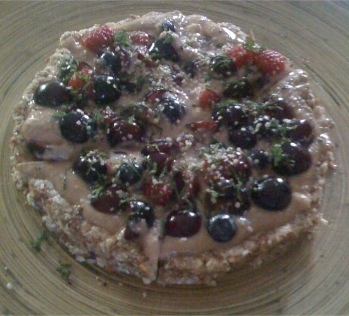 The other day I attended a workshop/dinner with the Javier Medvedovsky, the raw food chef I met at the Fira per la Terra, just before he left to spend the whole summer working in Ibiza.
The other day I attended a workshop/dinner with the Javier Medvedovsky, the raw food chef I met at the Fira per la Terra, just before he left to spend the whole summer working in Ibiza.
I had been wanting to learn more about raw food ever since I met him. Although it is still practically unheard of in Spain, the raw food movement is growing (or should I say sprouting?) all over the Western world.
One of the big problems of adapting the raw food movement to the Spanish speaking world is its title. "Comida cruda" or "crudivorismo" is not very appealing, it sounds like an allusion to a failed, undercooked meat. Javier proposes "comida con vida" (literally "live food"), which I rather like, it plays nicely with sound and meaning (the Spanish verb "convidar" also means "to offer" or "invite").
After a brief introduction, Javier spent a few hours "cooking", that is, preparing dinner for us and showing us some of the main the techniques of raw food: sprouting, dehydrating and marinating.
But I was most impressed by how amazing everything tasted.
Upon arrival, he made us a carrot, orange, and apple smoothie to sip on during his intro.
Then we learned about, and tasted, Rejuvelac, a fermented juice, an enzymatic natural probiotic made from sprouting grains, with a strong smell but a citrusy taste.
He then used the Rejuvelac to make almond cheese for the pizza we would try later.
This was followed by a glass of sunflower seed milk, delicious!
 The, before the main course, came dessert, a cake in three steps, made with a base of dates processed with almonds, a creamy filling of banana, sunflower seed pulp (left over from the milk -nothing goes to waste here), orange juice, and raspberries, and topped off with more raspberries, cherries, and blueberries. It was truly delicious and I will definitely try this one at home, the kids will love it.
The, before the main course, came dessert, a cake in three steps, made with a base of dates processed with almonds, a creamy filling of banana, sunflower seed pulp (left over from the milk -nothing goes to waste here), orange juice, and raspberries, and topped off with more raspberries, cherries, and blueberries. It was truly delicious and I will definitely try this one at home, the kids will love it.
Finally, the main course, a pizza, the dough of which was made mostly from the carrot pulp (left over from the juice), sprouted buckwheat, flaxseed, and oil. The pizza was topped with the almond cheese, lots of veggies, and black Greek olives. He served it with a colorful, flavor-rich salad. No metal was used, neither in the preparation of the food (only ceramic knives -I need some of these!), nor when we ate -only wood: plates, forks, chopsticks. Metal, according to Javier, oxidizes the raw food and should be avoided.
 I can't stress enough how delicious it all was (for some reason I guess I doubted it beforehand). The tastiness of it all makes me a big fan of raw food (and of Javier).
I can't stress enough how delicious it all was (for some reason I guess I doubted it beforehand). The tastiness of it all makes me a big fan of raw food (and of Javier).
But there are a couple of things that don't do the trick for me, and I don't think you'll see me turning into a crudivorista in this life. First, I find that too many ingredients are ground or milled. This is what allows them to play with textures and consistencies. Raw food insists on the food being alive at all times. But energetically, I'm not convinced that grinding it all up leaves it intact, I'm sure there are things that are lost in the process.
Second, if I were on a raw food diet, I'm sure I would miss fire. Summers are probably quite OK with this diet, but winters would be a true test. I love being next to the heat of the stove and oven, and eating hot food when it's cold outside (and sometimes when it's warm, too!).
Also, in order to follow a raw foods diet, you have to know a lot about nutrition, or receive the guidance of someone who does. It's too easy to abuse salads and fruits, and this can lead to serious nutritional deficiencies. I will from now on make it a point to visit raw food restaurants whenever I travel to places that have them, but will remain active next to the heat in the kitchen!

So fun to see raw food happening in Spain! It is a great way to eat!
ReplyDeleteWishing you the best,
Susan Powers